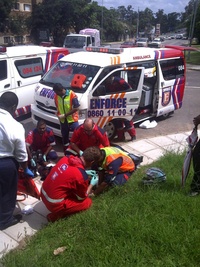
According to the latest stats from the U.S. Bureau of Labor Statistics, the Top 10 Most Dangerous Jobs in America are the following:
1. Fishing
If you’ve seen Deadliest Catch, you know why this has been the deadliest profession in America since 1992. Being pulled overboard, giant waves, malfunctioning gear and hellish weather are just some of the many hazards you can look forward to on the high seas.
Fatality Rate: 116 for every 100,000 workers and 29 total.
Annual Salary: $25,590
2. Logging Workers
More than half of the fatalities in logging are from being struck by an object. High altitudes, bad weather and working with heavy machinery are some of the many risk factors one can experience in an industry where you’ve always had to keep your whits about you despite technological improvements through the years.
Fatality Rate: 91.9 for every $100,000 workers and 59 total.
Annual Salary: $32,870
3. Aircraft Pilots and Flight Engineers
These guys spend their days with their head in the clouds, but when things go seriously wrong it’s a long fall right back down to earth. Of course, the main causes of death here are transportation accidents due to crashes.
Fatality Rate: 70.6 per 100,000 workers and 78 total.
Annual Salary: $118,070 for airline pilots and $76,050 for commercial pilots.
4. Farmers and Ranchers
This long suffering profession hasn’t gotten any safer with time, despite improvements in farming technology, and close contact with heavy machinery means farmers are frequently in danger of having a fatal accident.
Fatality Rate: 41.4 per 100,000 workers and 300 total.
Annual Salary: $60,750
5. Miners
Heavy machinery, extremely close and claustrophobic quarters and the possibility of explosions or rockfalls with nowhere to go make mining an extremely dangerous job. Mining machine operators have an even more dangerous profession with a fatality rate of 38.7 per 100,000 workers or 23 fatalities in total.
Fatality Rate: 19.9 per 100,000 workers; 172 total
Annual Salary: $37,230 to $89,440
6. Roofers
A slanted roof and an extremely tall ladder do not make for a safe line of work. Add to that weather and seasonal conditions that make roofs extremely slippery and you could probably guess that falls are the leading cause of death among roofers. Fractures and broken bones also make it one of the most injury-prone lines of work.
Fatality Rate: 32.4 per 100,000 workers and 57 total.
Annual Salary: $34,220
7. Garbage and Recycling Collectors
This job may not seem so dangerous, but it’s actually the fourth leading profession for non-fatal injuries, which are usually lacerations of some kind. Transportation accident also account for almost all of the fatalities in this job, which is certainly underrated as far as danger goes.
Fatality Rate: 29.8 per 100,000 workers and 26 total
Annual Salary: $34,420
8.Truck Drivers
Long hours, exhaustion and over exertion are just some of the risk factors over and above driving a 40 ton truck down a clogged highway that contribute to almost all of the fatalities here. While it is important for trucks to be in good working order making deliveries, some companies might not keep up with the necessary repairs or services needed to ensure that their trucks are safe to drive. This could result in accidents that can not only take the life of other drivers but also their own truck drivers. Finding a good repair service that could help with repairs is essential for any trucking company to keep its drivers and other motorists safe – visit this page for more information. Staying safe on the road is vital, especially when your job requires you to work long hours, through the day and night. One way you can stay safe is by looking into a site like ELD Reviews 2018 – The 10 Best Electronic Logging Devices to help monitor the hours you do over the day to then push the idea forward to drivers that taking your necessary breaks are important, especially if you are feeling tired and unable to complete a long journey without rest.
Non-fatal injuries and other health problems are also caused by poor posture while driving the truck for long periods. For this reason alone, the amount of people trying to find a truck accident lawyer in Los Angeles is rising. Los Angeles has a high amount of truck drivers, and accidents are common place. Different states might take a different approach so it might be worthwhile looking at other websites such as https://www.nehoralaw.com/huntington-beach-personal-injury-lawyers/.
Fatality Rate: 21.8 per 100,000 workers and 683 total.
Annual Salary: $37,930 for heavy truck drivers and $29,080 for light truck drivers.
9. Stuntman
Special effects and 3-D animation haven’t completely eradicated the need for a good old-fashioned qualified stuntman and despite many safety precautions it’s still a very dangerous profession. A stuntman recently suffered a major brain injury on the set of Hangover II and New Zealand actor Kevin Smith (Hercules the Legendary Journeys) fell from a scaffold on a movie set in 2002 and died.
Fatality Rate: The last available figures reflected 2.5 fatalities per 1,000 stunt workers.
Average Salary: $70,000
10. Police and Sheriff’s Patrol Officers
This one is pretty self-explanatory, especially for the U.S. Police 134 police and sheriff’s patrol officers lost their lives on the job in 2010, a 40 percent increase over 2009. Fifty-seven of the incidents were highway accidents, while 48 were reported as homicides. Police also occupy the second-highest rate of non-fatal injuries.
Fatality Rate: 18 per 100,000 workers and 133 total
Annual Salary: $56,250
Even though these are American statistics, there are many parallels to industries in Canada. Besides, regardless of your type of occupation, life insurance will likely be available. However, certain occupations may disqualify you from traditional life insurance policies where medical tests and a full list of questions are asked.
Thankfully, when traditional life insurance is not available, no medical life insurance policies may be a solution. There are two types of no medical life insurance policies Guaranteed Issue Life Policies, which have no medical tests and no health questions and Simplified Issue policies, which have no medical test and a short series of health questions.
Many Simplified Issue Policies provide coverage from day one and many of these policies do not have occupation-related questions.


